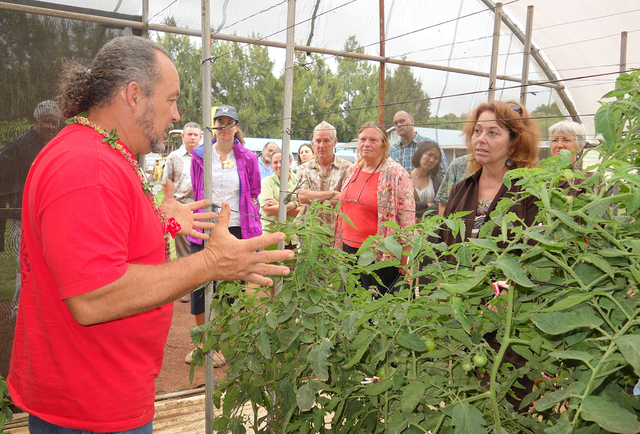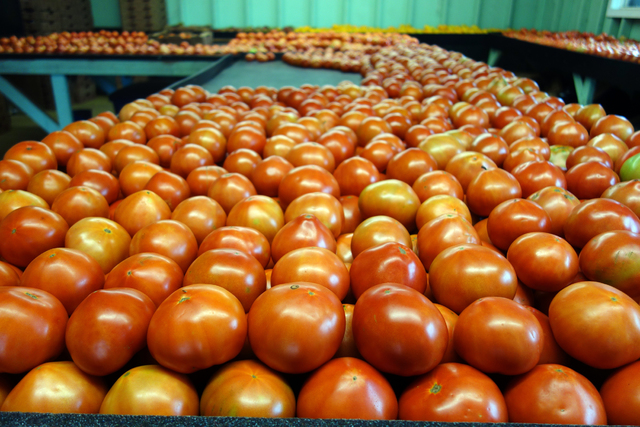KOHALA – As part of a three-day conference on the Kohala Coast this week, dozens of statewide representatives and Big Island partners gathered to brainstorm on local food production and how this key component of The Aloha+ Challenge can best be implemented statewide over the next 14 years.
This is one of six interconnected sustainability targets launched as part of The Aloha+ plan in July 2014.
Now nearly two years into the program, local food production and consumption is a key piece in the puzzle and methods are being further defined. The overall goal is to at least double food production, with 20 to 30 percent of food consumed grown locally by 2030.
Other Aloha+ focuses are clean energy, waste reduction, natural resource management, smart sustainable communities, and green workforce and education.
The group spent Wednesday morning at Kohala Village HUB in Hawi sharing initial ideas to use in the local food dashboard – an online platform designed for decision makers and the public to track progress on achieving Aloha+ targets.
“We saw a lot of leadership for the state and alignment for partners here,” Christin Reynolds said, measures coordinator for Hawaii Green Growth (HGG), the non-profit organization that helped launch The Aloha+ Challenge and continues to lead the initiative.
Representatives who participated came from County of Hawaii Department of Research and Development; USDA, Rural Development; USDA National Agricultural Statistics Service; Hawaii Department of Agriculture; University of Hawaii; Queen Liliuokalani Trust; Slow Food Hawaii; Malama Kauai; County of Maui; City and County of Honolulu; Kamehameha Schools; and Hawaii Conservation Alliance. Local ranchers, farmers, councilmembers and Kohala Center representatives shared personal insights of what they’ve seen work on the Big Island.
“The purpose (of the meeting) was to convene key stakeholders across private and public sectors and civil society to look at what the targets and indicators should be to monitor progress for the local food goal,” Celeste Connors said, HGG’s executive director. “Kohala Village HUB was amazing … extraordinary work they are doing and ways we can showcase what they’re doing through the dashboard. They are looking at economic sustainability, community resilience and ways to achieve objectives. These partners are doing that in practice.”
The June 28-30 meeting was a first step.
“We really looked at what’s important to people on the Big Island and across the state,” Connors said. “When we think about the importance of increasing local healthy food here youth came up a lot, sustainability for the future, how schools are involved and getting kids involved as they will be leading it in the future.”
In the afternoon, the group headed to the new Kohala Center campus for lunch. Chadd Paishon, Sr. Captain of Na Kalai Waa and Makalii, and his wife, Pomai Bertelmann, a crewmember, education specialist with Pacific Voyaging Society for World Wide Voyage and teacher at Kanu o ka Aina New Century Public Charter School, spoke at the lunch.
“As a ranch kid, we grew up with Spam and vegetables out of a can. That has changed. The resources are here to sustain us and care for us,” Bertelmann said.
The Kohala Center plays a key role in The Aloha+.
“The Kohala Center is a great example of ways that we should be living here in Hawaii,” Connors said. “We learn from each other and see them as part of our Hawaii Green Growth network. We look forward to working with them more.”
The afternoon concluded with a visit to WOW Farm in Waimea, where owner Mike Hodson shared how he and his family grow a variety of vine ripened tomatoes naturally, without chemicals or pesticides on Waimea Hawaiian Homestead land. He’s also been developing plans for a 161-acre ag park project the past three years.
“It’s really important to ground these conversations,” Reynolds said. “On the farm people brainstorm in different ways.”
Connors added, “Focus so far has been on how much food can be produced locally. Another focus is the concept of trust and value with our food system; more is not necessarily better. It’s how you do it, looking at everything from the land and farmers to production, distribution and consumption.”
The goal is to finalize the Aloha+ food dashboard by the end of the year.
“Between now and December, we will take back all of the values and recommendations, synthesize them into a mock up dashboard, follow up with all of the participants and visualize the information,” Reynolds said. “The next step is sharing a draft for another round and then the final sign off.”
Connors concluded, “We have to drive action towards achieving these goals. We work very closely with the counties, politicians and civil service and research and development. We’re having increased participation with Councilmembers Dru Kanuha and Margaret Wille who will coordinate the plan countywide. These align with the Sustainable Development Goals the U.N. adopted and has agreed to meet by 2030. We are really leading. I have not seen another state doing this. Other states and communities worldwide are starting to look at Hawaii’s model.”









